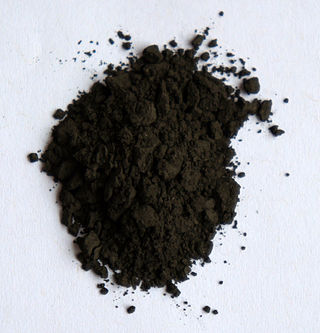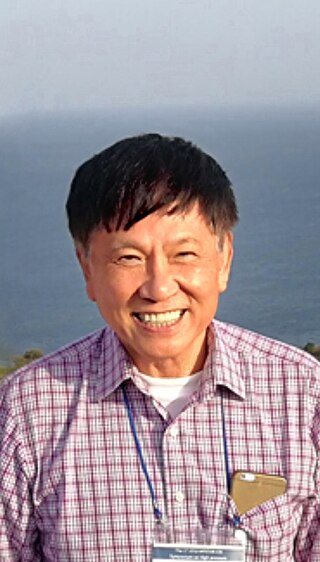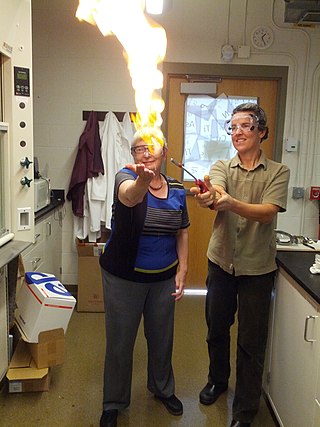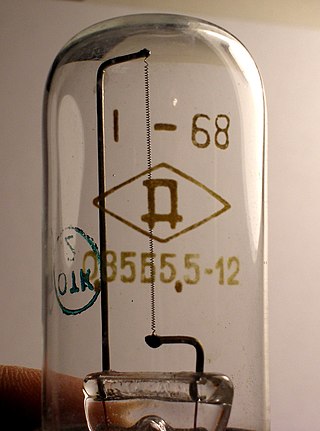
A metal is a material that, when freshly prepared, polished, or fractured, shows a lustrous appearance, and conducts electricity and heat relatively well. Metals are typically ductile and malleable. These properties are the result of the metallic bond between the atoms or molecules of the metal.

Goethite is a mineral of the diaspore group, consisting of iron(III) oxide-hydroxide, specifically the α-polymorph. It is found in soil and other low-temperature environments such as sediment. Goethite has been well known since ancient times for its use as a pigment. Evidence has been found of its use in paint pigment samples taken from the caves of Lascaux in France. It was first described in 1806 based on samples found in the Hollertszug Mine in Herdorf, Germany. The mineral was named after the German polymath and poet Johann Wolfgang von Goethe (1749–1832).

Iron oxides are chemical compounds composed of iron and oxygen. Several iron oxides are recognized. All are black magnetic solids. Often they are non-stoichiometric. Oxyhydroxides are a related class of compounds, perhaps the best known of which is rust.

In crystallography, the cubiccrystal system is a crystal system where the unit cell is in the shape of a cube. This is one of the most common and simplest shapes found in crystals and minerals.

Titanium hydride normally refers to the inorganic compound TiH2 and related nonstoichiometric materials. It is commercially available as a stable grey/black powder, which is used as an additive in the production of Alnico sintered magnets, in the sintering of powdered metals, the production of metal foam, the production of powdered titanium metal and in pyrotechnics.

Ho-Kwang (Dave) Mao is a Chinese-American geologist. He is the director of the Center for High Pressure Science and Technology Advanced Research in Shanghai, China. He was a staff scientist at Geophysical Laboratory of the Carnegie Institution for Science for more than 30 years. Mao is a recognized leading scientist in high pressure geosciences and physical science. There are two minerals named after him, Davemaoite and Maohokite.

At atmospheric pressure, three allotropic forms of iron exist, depending on temperature: alpha iron, gamma iron, and delta iron (δ-Fe). At very high pressure, a fourth form exists, epsilon iron. Some controversial experimental evidence suggests the existence of a fifth high-pressure form that is stable at very high pressures and temperatures.

Alexandra Navrotsky is a physical chemist in the field of nanogeoscience. She is an elected member of the United States National Academy of Sciences (NAS) and the American Philosophical Society (APS). She was a board member of the Earth Sciences and Resources division of the NAS from 1995 until 2000. In 2005, she was awarded the Urey Medal, by the European Association of Geochemistry. In 2006, she was awarded the Harry H. Hess Medal, by the American Geophysical Union. She is currently the director of NEAT ORU, a primary program in nanogeoscience. She is distinguished professor at University of California, Davis.
A hydrogen clathrate is a clathrate containing hydrogen in a water lattice. This substance is interesting due to its possible use to store hydrogen in a hydrogen economy. A recent review that accounts the state-of-the-art and future prospects and challenges of hydrogen storage as clathrate hydrates is reported by Veluswamy et al. (2014). Another unusual characteristic is that multiple hydrogen molecules can occur at each cage site in the ice, one of only a very few guest molecule that forms clathrates with this property. The maximum ratio of hydrogen to water is 6 H2 to 17 H2O. It can be formed at 250K in a diamond anvil at a pressure of 300MPa (3000 Bars). It takes about 30 minutes to form, so this method is impractical for rapid manufacture. The percent of weight of hydrogen is 3.77%. The cage compartments are hexakaidecahedral and hold from two to four molecules of hydrogen. At temperatures above 160K the molecules rotate around inside the cage. Below 120K the molecules stop racing around the cage, and below 50K are locked into a fixed position. This was determined with deuterium in a neutron scattering experiment.
Palle Rama Rao FREng is an Indian scientist noted for his contribution to the field of Physical and Mechanical Metallurgy. He has collaborated and conducted research activities for over dozen universities and associations all over India and abroad. He has been honoured with the titles of Padma Vibhushan in 2011 by president of India for his contributions to scientific community. He is acting as the chairman, Governing Council, International Advanced Research Centre for Powder Metallurgy & New Materials (ARCI), Hyderabad.
Chromium hydrides are compounds of chromium and hydrogen, and possibly other elements. Intermetallic compounds with not-quite-stoichometric quantities of hydrogen exist, as well as highly reactive molecules. When present at low concentrations, hydrogen and certain other elements alloyed with chromium act as softening agents that enables the movement of dislocations that otherwise not occur in the crystal lattices of chromium atoms.

Iron–hydrogen alloy, also known as iron hydride, is an alloy of iron and hydrogen and other elements. Because of its lability when removed from a hydrogen atmosphere, it has no uses as a structural material.
Ultra low velocity zones (ULVZs) are patches on the core-mantle boundary that have extremely low seismic velocities. The zones are mapped to be hundreds of kilometers in diameter and tens of kilometers thick. Their shear wave velocities can be up to 30% lower than surrounding material. The composition and origin of the zones remain uncertain. The zones appear to correlate with edges of the African and Pacific large low-shear-velocity provinces (LLSVPs) as well as the location of hotspots.
Nickel forms a series of mixed oxide compounds which are commonly called nickelates. A nickelate is an anion containing nickel or a salt containing a nickelate anion, or a double compound containing nickel bound to oxygen and other elements. Nickel can be in different or even mixed oxidation states, ranging from +1, +2, +3 to +4. The anions can contain a single nickel ion, or multiple to form a cluster ion. The solid mixed oxide compounds are often ceramics, but can also be metallic. They have a variety of electrical and magnetic properties. Rare-earth elements form a range of perovskite nickelates, in which the properties vary systematically as the rare-earth element changes. Fine tuning of properties is achievable with mixtures of elements, applying stress or pressure, or varying the physical form.
Russell Julian Hemley is an American geophysicist, solid-state physicist, and physical chemist.
Anat Shahar is a staff scientist at the Earth and Planets Laboratory, Carnegie Institution of Washington and adjunct professor at the University of Maryland. Her work uses high-pressure, high-temperature experiments and stable isotope geochemistry to understand the formation of planets in the Solar System.

Hemamala Indivari Karunadasa is an assistant professor of chemistry at Stanford University. She works on hybrid organic – inorganic materials, such as perovskites, for clean energy and large area lighting.

Catherine Ann McCammon is a Canadian geoscientist who is employed by the University of Bayreuth. Her research focuses on surface and mantle processes, as well as the physics and chemistry of minerals. She is a Fellow of the European Association of Geochemistry and American Geophysical Union. In 2013, she was awarded the European Geosciences Union Robert Wilhelm Bunsen medal. She is the editor of the journal Physics and Chemistry of Minerals.
A tellurite fluoride is a mixed anion compound containing tellurite and fluoride ions. They have also been called oxyfluorotellurate(IV) where IV is the oxidation state of tellurium in tellurite.

Davemaoite is a high-pressure calcium silicate perovskite mineral with a distinctive cubic crystal structure. It is named after geophysicist Ho-kwang (Dave) Mao, who pioneered in many discoveries in high-pressure geochemistry and geophysics.












